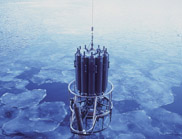Jul 7 2009
In Paris late last month the General Assembly of UNESCO's Intergovernmental Oceanographic Commission (IOC) accepted the case for the introduction of a new international thermodynamic description of seawater, cast in terms of a new salinity variable called Absolute Salinity.
 This instrument deployed from a research vessel measures temperature and salinity in the ocean. Variations in salinity and heat influence ocean currents and measuring those variations is central to quantifying the ocean’s role in climate change. Photo by: CSIRO
This instrument deployed from a research vessel measures temperature and salinity in the ocean. Variations in salinity and heat influence ocean currents and measuring those variations is central to quantifying the ocean’s role in climate change. Photo by: CSIRO
Hobart-based CSIRO Wealth from Oceans Flagship scientist, Dr Trevor McDougall, made the case during his presentation of the Bruun Memorial Lecture to the Paris meeting.
"Scientists will now have an accurate measure of the heat content of seawater for inclusion in ocean models and climate projections," Dr McDougall says.
"Variations in salinity and heat influence ocean currents and measuring those variations are central to quantifying the ocean's role in climate change. The new values for salinity, density and heat content should be in widespread use within 18 months."
Marine scientists have been searching for the 'magic formula' for measuring salinity – which varies from ocean to ocean and between tropical, temperate and polar regions – for more than 150 years.
"These variations in salinity and temperature are responsible for driving deep ocean currents and the major vertical overturning circulations of the world's oceans, which transfer ocean heat towards the Arctic and Antarctic regions," Dr McDougall says.
Unchanged since the last assessment 30 years ago, the case to review ocean thermodynamic measurements began in 2005 when the Scientific Committee on Oceanic Research (SCOR) established a working group, chaired by Dr McDougall. Supporting him were Dr Rainer Feistel from the Leibniz-Institut für Ostseeforschung in Warnemünde (Germany), Dr Frank Millero, from the Rosenstiel School of Marine and Atmospheric Science at the University of Miami in Florida, Dr Dan Wright of the Bedford Institute of Oceanography, Canada and Dr David Jackett of CSIRO.
Salinity, comprising the salts washed from rocks, is measured using the conductivity of seawater – a technique which assumes that the composition of salt in seawater is the same in all the world's oceans.
"The new approach, involving Absolute Salinity, takes into account the changes in the composition of seasalt between different ocean basins which, while small, are a factor of about 10 larger than the accuracy with which scientists can measure salinity at sea," Dr McDougall says.
Until the new description of seawater is widely adopted, ocean models will continue to assume that the heat content of seawater is proportional to a particular temperature variable called "potential temperature".
"The new description allows scientists to calculate the errors involved by using this approximation while also presenting a much more accurate measure of the heat content of seawater, namely Conservative Temperature," Dr McDougall says.
"The difference is mostly less than 1ºC at the sea surface, but it is important to correct for these biases in ocean models."